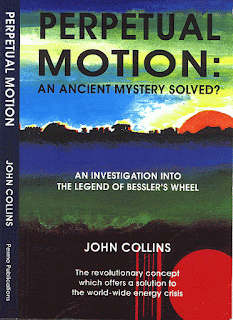I usually prefer to ignore the discussion about the term ‘perpetual motion’, because it has become confusing and the definition has altered between Bessler’s time and today. I think we all know what we mean by the term, the wheel that speeds up to a certain speed and maintains it indefinitely. Even Bessler questioned the use of the phrase, he said it could not literally be perpetual, because the materials of which it was made could not last, and there would be wear and tear etc. He called it ‘Perpetual Motion, as they say’ or ‘as it were’, implying that it was called that by habit but was not correct. His exact wording in AP, ‘Perpetuum mobile per se’, which translated is, ‘by or in itself or themselves; intrinsically.’ In reality I prefer terms such as , ‘continuous or sustained or constant motion’, which doesn’t imply that it’s perpetual, but is non-stop or continuous at a particular moment.
I think that we have to stop looking for any other source of energy, it’s clear to me that however you look at it, gravity lies at the heart of Bessler’s wheel. We have endlessly argued that gravity cannot be the source of energy for the device, but there isn’t anything else. I myself and others have researched, studied, experimented, built models, right from the start, myself for over 50 years, but there is nothing that fits in with what we know of Bessler’s wheel, as he described it except using the force of gravity.
We know gravity is a force, an attraction between objects of mass, for instance, and it gives weights their……weight. When motionless they retain their gravitational input as potential energy, when dropping they are expending that same energy as kinetic energy. We also know it isn’t a source of energy, at least not in the literal sense. But it does supply a continuous force which we routinely use, via streams of water for instance. Water is the connecting medium between gravity and say a water mill and the weights are the connecting medium between gravity and the mechanisms in Bessler’s wheel.
We work with formulae that can predict the work done by gravity and it sometimes seems as though the weight is inherent within the mass, but it’s not, it’s the force of gravity giving it that weight. In gravity-less conditions the weights become weightless. In space it is the attributes of mass which provide it’s amount of inertia or resistance to being moved or being stopped moving. That inertia is acted on by gravity, and the greater the mass the greater the affect of gravity.
In the end Bessler’s wheel used weights to make it turn continuously, gravity caused the weights to fall, the right configuration of the weights allowed the fallen weights to rise to their pre-fall position. It’s perfectly possible and it cannot act contrary to the established laws of physics no matter how much we are told it must.
One more thing; the wheel was able to do work as well as simply turn. A distinct gap between the energy generated by the falling weights and that expended in returning each one to its pre-fall position must have been present, sufficient to provide a mechanical advantage . This extra energy was enough to not only drive the wheel round but also continue to do extra work, i.e. lift heavy weights, drive an Archimedes water pump etc. This is a logical outcome of the inclusion of weights reacting to the force of gravity. Within the gap the heavier the weights used, the more powerful the wheel; either lifting heavier loads or turning faster. This additional work could be modified by alterations to the internal configuration, while retaining the continuous rotational ability.
So the energy Bessler’s wheel used to make it turn continuously was derived from the falling of the weights, and their subsequent placement prior to their return to their pre-fall position.
The energy was generated by each falling weight, but the particular configuration in Bessler’s wheel, allowed it to raise the weights at less cost in energy than that generated in their fall, hence the supplementary energy available for turning the wheel and doing work.
JC



